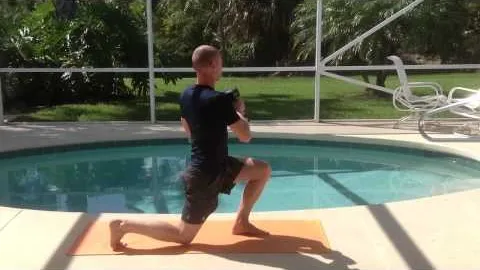Dumbbell Reverse Lunge and Rotation Exercise
One effective exercise that targets multiple muscle groups and enhances balance and stability is the Dumbbell Reverse Lunge and Rotation. This exercise combines a traditional lunge movement with a rotational component, making it a great choice for building lower body strength and improving core stability.
To perform the Dumbbell Reverse Lunge and Rotation exercise, you will need a pair of dumbbells and ample space to move. Follow these steps to ensure proper form and maximize the benefits of this exercise:
Step 1: Preparing for the Exercise
- Begin by choosing an appropriate pair of dumbbells that corresponds to your fitness level. Start with lighter weights if you are new to this exercise or gradually increase the weight as you progress.
- Stand tall with your feet hip-width apart and hold the dumbbells in each hand, keeping your arms by your sides.
- Brace your core and engage your abdominal muscles to stabilize your spine.
Step 2: Executing the Exercise
- Step back into a reverse lunge: Lift your right foot off the ground and take a big step backward with your right leg. Lower your right knee towards the ground, forming a 90-degree angle with your right leg. Simultaneously, bend your left knee to a 90-degree angle, ensuring that it remains aligned with your ankle.
- Rotate your torso: As you lower into the lunge position, rotate your torso to the left, turning your upper body away from your front leg. Keep your core engaged throughout the rotation to maintain stability and protect your back.
- Return to the starting position: Push through the heel of your left foot, engaging your quadriceps and glutes to rise back up and lift your right leg to the starting position. Align your feet with your hips again, ensuring proper balance.
- Repeat on the other side: Now, perform the reverse lunge and rotation movement with your left leg, stepping back and rotating your torso to the right. Remember to keep your core stable and controlled during the entire movement.
Step 3: Common Errors and Tips
- One common error is letting your knee extend past your toes during the lunge. Ensure your front knee remains in line with your ankle, as this helps to maintain proper alignment and avoid strain on the knee joint.
- Maintain an upright posture throughout the exercise. Avoid leaning forward or rounding your shoulders, as this can put unnecessary stress on your lower back.
- Focus on maintaining your balance during the rotation. Engage your core, squeeze your glutes, and imagine a straight line from the top of your head to the bottom of your opposite foot.
Benefits of Dumbbell Reverse Lunge and Rotation Exercise
The Dumbbell Reverse Lunge and Rotation exercise offers several benefits for your overall fitness and well-being:
- Leg strength: This exercise targets the quadriceps, hamstrings, and gluteal muscles. By performing reverse lunges, you can enhance strength and muscular endurance in your lower body.
- Core stability: The rotational component of this exercise engages your core muscles, particularly the obliques, in order to stabilize your spine. This can improve your overall balance and functional movement patterns.
- Improved balance: By challenging your stability and forcing your muscles to work together, this exercise helps improve your balance and coordination. This can be especially beneficial for older adults or athletes looking to enhance their athletic performance.
- Added intensity: Holding dumbbells during this exercise increases the resistance and adds an extra challenge for your muscles. This helps to promote muscle growth and strength development.
Conclusion
Incorporating the Dumbbell Reverse Lunge and Rotation exercise into your workout routine can provide a multitude of benefits for your lower body strength, core stability, balance, and coordination. Remember to start with lighter weights and focus on maintaining proper form throughout the exercise. With consistency and dedication, you can reap the rewards of this compound movement and enhance your overall fitness level.
